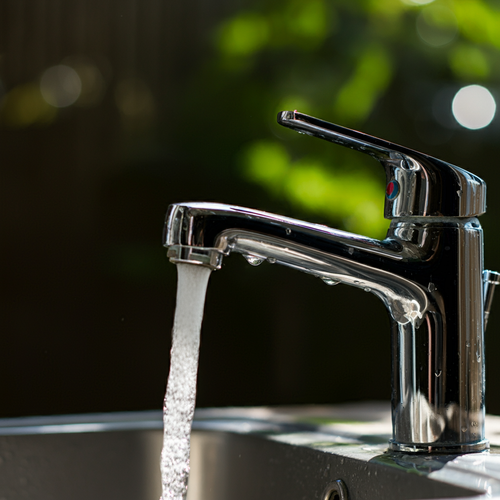Understanding Iron in Well Water
Iron sneaks into many folks' well water and knowing its impact can save a lot of stress. Let's chat about what iron does to your water and how you can spot it hanging around in your water supply.
Effects of Iron in Water
Iron in your water isn't just a minor nuisance—it can cause some real headaches. You know those rusty marks on your sinks and bathtubs? You can thank iron for that.
It turns to rust when water and air get involved, painting everything orange, from your bathroom fixtures to your favorite white shirt (Minnesota Department of Health). But wait, there's more:
- Weird Taste: Water high in iron can taste like you’re sucking on a penny—not the most refreshing experience.
- Clogged Pipes: Iron likes to settle inside pipes, narrowing them down like your aunt’s arteries after too many cheeseburgers.
- Spotty Dishes: Think your dishwasher is cutting it? Iron will leave ugly spots on your plates.
- Stained Laundry: If your whites come out looking like they've been dipped in tea, you might have an iron issue.
Signs of Iron Presence

Spotting iron in water isn't rocket science. Here are some clues:
- Water Color: If your water has turned into a yellow or red lemonade, there’s iron lurking.
- Taste and Smell: A metallic taste with a twist of earthiness (it's not as delicious as it sounds) hints at iron.
- Cloudiness: When iron hits the air, it clouds up your water like a fog on a dreary morning, painting it a rusty brown (IDPH Illinois).
| What to Look For | What's Happening |
|---|---|
| Water Color | Yellow or Red |
| Taste | Metallic |
| Smell | Earth-like or Musty |
| Cloudiness | Reddish-Brown in the open air |
Spotting these signs and understanding what iron can do is key to putting those rusty worries to rest with proper water treatment.
Fixing Iron in Your Well Water
Keeping our well water fresh and iron-free is a must. Let's look at some ways to tackle iron in water and what type does what to the plans.
Iron Filtration Choices
Getting rid of iron in well water isn't just about better tasting water — it also helps our appliances last longer. Here's what's out there:
-
Water Softeners: Think of these as iron magnets. They swap iron out and pull in another element. Most water softeners tackle up to 10 mg/L of iron, but they're usually better suited for 2 to 5 mg/L jobs.
-
Manganese Greensand Filters: They're like multi-taskers, handling iron, manganese, and stinky hydrogen sulfide. They take soluble iron and turn it into the stuff that filters out.
-
Reverse Osmosis (RO) Systems: These are the overachievers, catching iron ions and almost anything else, like germs and heavy metals, on their super fine filter.
-
Distillation Units: This one's like a magic act—water turns to vapor, leaving iron behind, then returns to clean liquid. Voila, no iron!
-
Iron and H2S Filters: These keep costs down and gadgets running well by zapping iron and hydrogen sulfide.
| Filtration Kind | Works With | Extra Perks |
|---|---|---|
| Water Softener | Holds up to 10 mg/L | Makes water softer |
| Greensand Filter | Good for iron & smell issues | Does many things |
| Reverse Osmosis | Super precise | Kicks out more than just iron |
| Distillation | Removes it all | Pure water earns brownie points |
| Iron/H2S Filter | Iron, hydrogen sulfide zapped | Saves energy |
Iron Types and How to Deal
Different irons need different falls from grace. Here's how they stack up:
-
Ferrous (Clear-Water) Iron (Fe²⁺): Dissolves like sugar in tea. Exposes to air, turns color, stains. Use water softeners or greensand (source: Minnesota Department of Health).
-
Ferric Iron (Fe³⁺): This one's a solid party, giving water a yellow, orangey look. Greensand and sediment filters do the trick.
-
Colloidal Iron: Tiny particles that cling on. Can't filter out with regular stuff, so RO systems can clean it up.
-
Organic Iron: Dresses up with organic pals, hard to treat. Needs distillation or RO to kick it out.
-
Bacterial Iron: It’s sticky business, sometimes looking and feeling like slime. Needs chlorination and filtering.
| Iron Type | Looks Like | Dos and Don'ts |
|---|---|---|
| Ferrous Iron (Fe²⁺) | Clear, then yellow or brown | Use Water Softeners, Greensand |
| Ferric Iron (Fe³⁺) | Yellow, orange, red | Get with Greensand, sediment filters |
| Colloidal Iron | Cloudy, murky | Go RO for the win |
| Organic Iron | Water turns funny colors | Distil or RO solution needed |
| Bacterial Iron | Slick, gooey | Chlorinate then filter |
With this knowledge in hand, we can figure out which tools fit our needs best for getting our well water iron-free and clean.
Choosing the Right Iron Filter
Figuring out which iron filter suits your well water isn't rocket science. There are a few things you gotta think about, and we're here to walk you through it all, step by step.
From what to weigh up, to what types of filters are hanging around on the market, we've got it covered.
Factors to Consider
When picking out an iron filter, here's the lowdown:
-
Iron Levels: First off, how much iron are we talking about here? If it's over 0.3 mg/L, it’s usually a no-go, with most folks dealing with something between 2 and 5 mg/L—a common range in many households.
-
Iron Variety: Is it ferrous or ferric iron messing with your water? Like, is it invisible till it hits air, or does it come out looking like your rusty old wagon? The treatment choice depends on which one it is.
-
Other Junk in the Water: Got some other stuff swimming around in there, like tannins or organic iron? That's gonna muck with the normal iron removal, so take note (Minnesota Department of Health).
-
Daily Water Use: What's your family guzzling down each day? Make sure your pick can keep up.
-
Maintenance Hassle: How often you gotta crack open that filter for cleanup or a switch-around? Better to know before you commit!
Types of Iron Filters
Alright, so you’ve got options when it comes to iron filters—each with its own talent for removing iron particles from drinking water.
Manganese Greensand Filters
These iron removal filters are champs for sorting out ferrous iron. They use this stuff called potassium permanganate to zap the iron muck into oblivion.
| Iron Concentration | Common Range | Max Removal |
|---|---|---|
| Ferrous Iron | 2 - 5 mg/L | Up to 10 mg/L |
Catalytic Filtration
Catalytic filtration spins a different tale. It uses a catalyst to change soluble iron into solid stuff that's easy to catch and remove—handy if there’s more than just iron causing a ruckus.
| What’s In the Water | Iron & Friends |
|---|---|
| Effectiveness | High |
Chlorine-Based Oxidation Filters
These are all about chlorine—isn't everything? Mix this with your water, and ferrous iron turns into little iron-nuggets you can filter out. The full process works effortlessly.
| Iron Concentration | Common Range | Technique |
|---|---|---|
| Ferrous Iron | 2 - 5 mg/L | Oxidation |
Aeration/Filtration Systems
This iron remover is your buddy here— it gets mixed with water to zap iron into a filterable form. Suits both ferrous and ferric kinds.
| Process | Oxidation | Filtration |
|---|---|---|
| Iron Type | All Shapes & Sizes | Works for Both |
Water Softeners
If you thought these were just for hard water treatment for your drinking water, guess again. They play a part in tackling ferrous iron, swapping it out for sodium instead.
| Iron Concentration | Common Range | Max Removal |
|---|---|---|
| Ferrous Iron | 2 - 5 mg/L | Up to 10 mg/L |
When we weigh these factors and grasp the filter options, we're better equipped to nail down the perfect iron filter for our well water setup. Time to ensure the water we rely on is clear and safe—nobody wants to drink a rusty faucet, right?
Maintenance and Longevity
To ensure your water system is optimized and iron-free, consider using a Water System Calculator to assess your needs effectively.
Let’s face it, nobody wants rusty water, right? Keeping your iron filter system in tip-top shape isn’t just a good idea; it’s how you keep that water flowing smooth and iron-free.
Keeping Your Filter Pumped Up
Having your iron filter cranking at its best might not be rocket science, but it helps to know a couple of tricks. Swapping out tired filter media, dusting off the cobwebs, and checking those pressure gauges so they don’t get all jammed up are key.
Must-Do Maintenance Tasks:
- Refreshing Media: Don’t be shy. Give that filter media a swap now and then. Check what the manufacturer suggests for timing.
- Scrub-a-Dub-Dub: A bit of clean-up with approved solutions keeps everything from going gunky.
- Pressure Glance: That pressure gauge is your new BFF. You gotta watch it to spot any sneaky blockages messing with the flow.
| What To Do | How Often |
|---|---|
| Media Swap | Every 6-12 months |
| Give It a Clean | Every 3 months |
| Gauge Check | Monthly |
How Long Will This Thing Last?
Wondering how long before you have to shop for a new iron filter system? A lot depends on the filter's type, the water it’s dealing with, and whether you’re giving it the TLC it needs.
Most systems stand the test of time—think 5 to 10 years for the well-cared-for ones. But, there’s always a catch, right?
| Filter Type | Average Lifespan |
|---|---|
| Water Softeners (Ion Exchange) | 10-15 years |
| Reverse Osmosis (RO) Systems | 10-15 years |
| Manganese Greensand Filters | 5-10 years |
| Catalytic Filters | 8-12 years |
What messes with the lifespan:
- Water Woes: If your water’s about to rust up BBQ grills, it’s going hard on your filters too.
- Use It or Lose It: More gulping means faster wear.
- Keep It Fresh: Being all proactive and showing some love with regular maintenance might just let it outlast even your favorite pair of jeans.
With a little know-how and elbow grease, keeping your water crisp, clean, and iron-free isn’t just a dream; it’s a way of life.


















![Aldex Premium 10% Cross Link Resin for Water Softener [High Capacity]-SoftPro® Water Systems](http://www.softprowatersystems.com/cdn/shop/files/Aldex_10_Cross_Link_Resin_Premium_High_Capacity_for_Water_Softener_600x.jpg?v=1735853599)






















